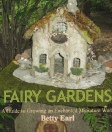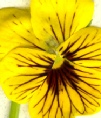Website and Images © 2014 Betty Mackey
Something Special in Garden Books





Colorful, scented flowers can be an edible treat as well as a visual delight. Flower flavors range from mild to sweet to pungent. Imagine petals of orange and red spicy nasturtiums tossed into a green salad, sweet, candied violets on a cake, and aromatic red pineapple-sage blossoms atop a sorbet. Violas and blue borage flowers are sometimes frozen into decorative ice cubes. You can have squash blossom fritters, orchids as a garnish for a serving platter, and chicken salad served inside a tulip flower (minus the stamens). Many chefs and cooks use fresh flowers as delicate to outrageous accents for extraordinary dining. The larger the flower, the greater the visual impact.
It isn’t easy to buy flowers for the dinner plate, so famed chef Alice Waters grew her own edible flower garden for her San Francisco restaurant, Chez Panisse. Rosalind Creasy takes us on a tour of it with her and also shares some of Ms. Waters’s recipes in the book, The Edible Flower Garden.
Not all flowers are edible, so it takes knowledge and planning to use them for edible garnishes and dining. Certain types taste nasty, and a few are poisonous. You wouldn’t want to eat florist flowers because they probably have been sprayed with pesticides and dosed with floral preservatives. Look for organically grown flowers intended for the table, or grow your own in the garden, which also helps with plant identification. You can set aside space just for edible flowers, or graze through the garden if you grow flowers organically.
Pick flowers just as soon as they open, for, like fruit, they need to ripen but not spoil. Rinse them off gently and be sure you have not brought in pests. Refrigerate the trimmed flowers inside plastic packaging lined with a dampened paper towel and use them within two days.
How can you tell whether a flower is edible? The safest thing is to assume that it is not, unless it is one of those types known to be safe. Even so, it is best to eat just a little, at first, to make sure that you are not allergic. Remove pollen-bearing anthers because some people are allergic to pollen.
Flowers of edible plants are generally a good choice. Some of the best of these blossoms for table use are bean and edible pea flowers (but not sweet peas). They have a bit of vegetable taste, but it is sweeter, fruitier, and more fragrant. You can use the blossoms of virtually all the culinary herbs, such as rosemary, sage, lavender, borage, chamomile, parsley, dill, thyme, mint, anise hyssop, bee balm, sweet woodruff, cilantro, and fennel. Do not use blossoms of eggplant, tomato, potato, or peppers.
Squash, pumpkin, watermelon, and cucumber blossoms (but not gourd blossoms) are used in a number of ways: in fritters, as a garnish, and as colorful accents for a salad. Cucumber is my favorite, for it is a flat little lemon-yellow flower about an inch in diameter with a bit of cucumber flavor. A cucumber plant makes lots more flowers than cukes. Squash and cucumber blossoms should be picked early in the morning and refrigerated for use later in the day, for they close at midday.
Other yellow or white flowers form when radishes, turnips, cabbages, broccoli, and kale start to bolt (go to seed). Instead of pitching out the plants, harvest the spicy, piquant flowers, which are ideal salad material. Even the seed pods can be used if they are young and juicy, not stringy.
From fruit trees you can provide apple, peach, or plum blossoms (just the petals), and lemon and orange blossoms if you have potted specimens. Elderberry bushes have flat sprays of white flowers that can be shaken into fritter or pancake batter.
The onion family has flowers that may be too rank for a bouquet, but which are perfect for flavoring vinegar, meats, salads, and pastas. Try using the star-shaped, fresh, young flowers of culinary chives, garlic chives, onions, and leeks. Even weeds can be tasty, such as the yellow petals of dandelions, but only if picked from unsprayed areas. Of course you have heard of dandelion wine.
Stepping into the flower garden, you can eat the petals of roses, sunflowers, chrysanthemums, violets, pansies, violas, marigolds, portulaca, daylily, hibiscus, nasturtium, calendula, tulip, begonia, impatiens, and gladiolus, among others. Each has its own distinctive colors and flavors. Begonias have a citrusy flavor. Daylilies come in many colors, and the flavor varies with the cultivar. Yellows are generally milder and more pleasant than the darker shades. The unopened flower buds are used in soups and stews, most notably in Chinese hot and sour soup.
Learning which types of flowers are savory and edible is very important, for there are other flowers that range from unappetizing to bitter to dangerously toxic. If you can’t identify a plant as positively edible, avoid it. Never taste daffodils (narcissi), iris, hellebores, morning glories, larkspur, petunias, monkshood, delphiniums, larkspur, petunias, flowering tobacco, anemone, or hyacinth.
Bill Thomas, Executive Director of Chanticleer, points out that, “Not every flower that shows up on a plate is edible (plates don't reject poisonous flowers and chefs often don't have a clue, so I never eat it unless I know for sure it is edible).” He also relates that Cathy Barash, author of the book, Edible Flowers from Garden to Palate, visited his garden when his Prunus mume was in fragrant, cinnamon-scented bloom. “I didn't know they were edible,” he said, “and she almost fainted from excitement, since she had never seen one in bloom. They are delicious.”
Your best guide to identifying edible flowers is an illustrated book with good, clear photographs of the flowers, such as those listed below. They also contain flower lore, handling instructions, recipes, menus, and delightful serving suggestions.
© Betty Mackey
The Edible Flower Garden (Edible Garden Series). by Rosalind Creasy. 112 pages Periplus Editions (part of Tuttle Publishing), London and Boston, 2000 (paperback edition).
Edible Flowers from Garden to Palate, by Cathy Wilkinson Barash. 250 pages. Fulcrum Publishing, Golden, Colorado, 1993.
Edible Flowers: Desserts & Drinks, by Cathy Wilkinson Barash. 84 pages. Fulcrum Publishing, Golden, Colorado, 1997.
Flowers in the Kitchen: A Bouquet of Tasty Recipes, by Susan Belsinger. 128 pages. Interweave Press, Loveland, Colorado, 1991.
A LIVELY SALAD STORY!
"A friend hosted an elegant luncheon. The day before, she harvested violets and other early spring flowers, gave them a quick rinse, and popped them in paper towels in the refrigerator. The morning of the luncheon, she carefully placed a colorful array of mixed greens on the plates, artfully arranged the flowers over, and had them ready for dressing and presentation.
There were several hours between arranging and luncheon, and the salads warmed a bit. She noticed as she started to drizzle the Raspberry-Pecan dressing that the flowers seemed to be moving. On closer inspection, it was the phalanxes of Aphids on the march that gave movement to the salad course."
– Daryl Pulis, Garden Writer
